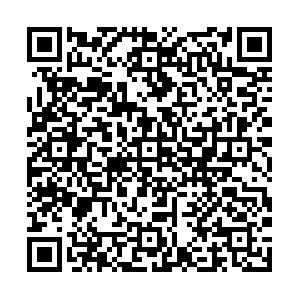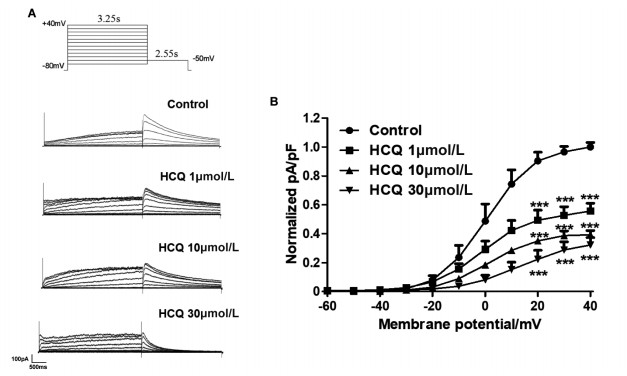Hydroxychloroquine induces long QT syndrome by blocking hERG channel
doi: 10.2478/fzm-2023-0014
-
Abstract:
Objective In March 2022, more than 600 million cases of Corona Virus Disease 2019 (COVID-19) and about 6 million deaths have been reported worldwide. Unfortunately, while effective antiviral therapy has not yet been available, chloroquine (CQ)/hydroxychloroquine (HCQ) has been considered an option for the treatment of COVID-19. While many studies have demonstrated the potential of HCQ to decrease viral load and rescue patients' lives, controversial results have also been reported. One concern associated with HCQ in its clinical application to COVID-19 patients is the potential of causing long QT interval (LQT), an electrophysiological substrate for the induction of lethal ventricular tachyarrhythmias. Yet, the mechanisms for this cardiotoxicity of HCQ remained incompletely understood. Materials and methods Adult New Zealand white rabbits were used for investigating the effects of HCQ on cardiac electrophysiology and expression of ion channel genes. HEK-293T cells with sustained overexpression of human-ether-a-go-go-related gene (hERG) K+ channels were used for whole-cell patch-clamp recordings of hERG K+ channel current (IhERG). Quantitative RT-PCR analysis and Western blot analysis were employed to determine the expression of various genes at mRNA and protein levels, respectively. Results electrocardiogram (ECG) recordings revealed that HCQ prolonged QT and RR intervals and slowed heart rate in rabbits. Whole-cell patch-clamp results showed that HCQ inhibited the tail current of hERG channels and slowed the reactivation process from inactivation state. HCQ suppressed the expression of hERG and hindered the formation of the heat shock protein 90 (Hsp90)/hERG complex. Moreover, the expression levels of connexin 43 (CX43) and Kir2.1, the critical molecular/ionic determinants of cardiac conduction thereby ventricular arrythmias, were decreased by HCQ, while those of Cav1.2, the main Ca2+ handling proteins, remained unchanged and SERCA2a was increased. Conclusion HCQ could induce LQT but did not induce arrhythmias, and whether it is suitable for the treatment of COVID-19 requires more rigorous investigations and validations in the future. -
Key words:
- COVID-19 /
- hydroxychloroquine /
- LQT /
- hERG /
- Hsp90
-
Figure 1. HCQ blocks the hERG potassium channel current (IhERG) in hERG-overexpressing HEK293T cells (hERG-HEK293T)
(A) Whole-cell voltage-clamp protocol and representative hERG current traces recorded from different experimental groups after expose of 1, 3, and 10 μmol/L HCQ. (B) Normalized I-V relationships for tail current in the presence of HCQ. N = 6, ***P < 0.001 vs. control.
Figure 2. The effect of HCQ on hERG channel kinetics in hERG-overexpressing HEK293T cells (hERG-HEK293T)
(A) Voltage-dependent activation curves for the control cells and the cells after exposure to HCQ for 24 h and the V50 and (B) slope value. (C) Whole-cell voltage-clamp protocol and representative current tracing for steady-state inactivation. (D) I-V relationships for inactivation current in the presence of HCQ. (E) The effect of HCQ on inactivation curve after incubated for 24 h and the V50 and (F) slope value. (G) Voltage-clamp protocol and representative current tracing for the onset of inactivation. (H) Voltage-clamp protocol and representative current tracing for the recovery from inactivation. (I) The effect of HCQ on the time constants of inactivation and recovery from inactivation after incubation for 48 h. Data are presented as mean ± SEM N = 6, *P < 0.01, **P < 0.05, ***P < 0.001 vs. control.
Figure 3. The effects of HCQ on cardiac electrophysiology
(A) The representative diagram of ECG in rabbits. (B-G) HCQ prolongs QTc (B), QT interval (C) and max-RR interval (D), min-RR interval (E), mean RR interval (F) and decreases heart rate (G) in rabbit heart. (H-I) Whole-cell voltage-clamp protocol and representative hERG current traces recorded from hERG-HEK293T cell line treated with 1, 3, and 10 μmol/L HCQ. Normalized I-V relationships for tail current in the presence of HCQ. N = 6, *P < 0.01, ***P < 0.001 vs. control.
Figure 4. Effects of HCQ on the expression of cardiac ion channels and their regulatory proteins in rabbit hearts
(A) Relative mRNA level after HCQ administration for 1 week. HCQ incubation remarkably reduced the mRNA level of hERG and had no effect on (B) Hsp90 and (C) HSP70. (D) Western blots results and statistics of HSP70 expression. HCQ incubation does not decrease the expression level of Hsp70. (E-H) Relative mRNA or protein level after HCQ administration for 1 week. HCQ incubation remarkably reduced the mRNA level of (E) Cx43 and (F) Kir2.1 and increased the expression of (G-H) SERCA2a and had no effect on (I-J) CaV1.2. N = 5-7, *P < 0.01, **P < 0.05 vs. control.
-
[1] Filchakova O, Dossym D, Ilyas A, et al. Review of COVID-19 testing and diagnostic methods [J]. Talanta, 2022; 244: 123409. doi: 10.1016/j.talanta.2022.123409 [2] Trivedi N, Verma A, Kumar D. Possible treatment and strategies for COVID-19: review and assessment. Eur Rev Med Pharmacol Sci, 2020; 24(23): 12593-12608. [3] Wang M, Cao R, Zhang L, et al. Remdesivir and chloroquine effectively inhibit the recently emerged novel coronavirus (2019-nCoV) in vitro. Cell Res, 2020; 30(3): 269-271. doi: 10.1038/s41422-020-0282-0 [4] Jorge A, Ung C, Young L, et al. Hydroxychloroquine retinopathy - implications of research advances for rheumatology care. Nat Rev Rheumatol, 2018; 14(12): 693-703. doi: 10.1038/s41584-018-0111-8 [5] McChesney E W. Animal toxicity and pharmacokinetics of hydroxychloroquine sulfate. Am J Med, 1983; 75(1a): 11-18. [6] Gautret P, Lagier J C, Parola P, et al. Hydroxychloroquine and azithromycin as a treatment of COVID-19: results of an open-label non-randomized clinical trial. Int J Antimicrob Agents, 2020; 56(1): 105949. doi: 10.1016/j.ijantimicag.2020.105949 [7] Borba M G S, Val F F A, Sampaio V S, et al. Effect of high vs. low doses of chloroquine diphosphate as adjunctive therapy for patients hospitalized with severe acute respiratory syndrome coronavirus 2 (SARS-CoV-2) infection: a randomized clinical trial. JAMA Netw Open, 2020; 3(4): e208857. doi: 10.1001/jamanetworkopen.2020.8857 [8] Vincent M J, Bergeron E, Benjannet S, et al. Chloroquine is a potent inhibitor of SARS coronavirus infection and spread. Virol J, 2005; 2: 69. doi: 10.1186/1743-422X-2-69 [9] Lescure F X, Bouadma L, Nguyen D, et al. Clinical and virological data of the first cases of COVID-19 in Europe: a case series. Lancet Infec Dis, 2020; 20(6): 697-706. doi: 10.1016/S1473-3099(20)30200-0 [10] In't Veld A E, Jansen M A A, Ciere L C A, et al. Hydroxychloroquine effects on TLR signaling: Under exposed but unneglectable in COVID-19. J Immunol Res, 2021; 6659410. [11] Torigoe M, Sakata K, Ishii A, et al. Hydroxychloroquine efficiently suppresses inflammatory responses of human class-switched memory B cells via Toll-like receptor 9 inhibition. Clin Immunol, 2018; 195: 1-7. doi: 10.1016/j.clim.2018.07.003 [12] Meo S A, Klonoff D C, Akram J. Efficacy of chloroquine and hydroxychloroquine in the treatment of COVID-19. Eur Rev Med Pharmacol Sci, 2020; 24(8): 4539-4547. [13] Lopez A, Duclos G, Pastene B, et al. Effects of hydroxychloroquine on COVID-19 in intensive care unit patients: preliminary results. Int J Antimicrob Agents, 2020; 56(5): 106136. doi: 10.1016/j.ijantimicag.2020.106136 [14] Molina J M, Delaugerre C, Le Goff J, et al. No evidence of rapid antiviral clearance or clinical benefit with the combination of hydroxychloroquine and azithromycin in patients with severe COVID-19 infection. Med Mal Infect, 2020; 50(4): 384. doi: 10.1016/j.medmal.2020.03.006 [15] Good M I, Shader R I. Lethality and behavioral side effects of chloroquine. J Clin Psychopharmacol, 1982; 2(1): 40-47. doi: 10.1097/00004714-198202000-00005 [16] Al-Bari M A. Chloroquine analogues in drug discovery: new directions of uses, mechanisms of actions and toxic manifestations from malaria to multifarious diseases. J Antimicrob Chemother, 2015; 70(6): 1608-1621. doi: 10.1093/jac/dkv018 [17] Doyno C, Sobieraj D M, Baker W L. Toxicity of chloroquine and hydroxychloroquine following therapeutic use or overdose. Clin Toxicol (Phila), 2021; 59(1): 12-23. doi: 10.1080/15563650.2020.1817479 [18] Yendrapalli U, Ali H, Green J L, et al. Effects of cardiac toxicity of combination therapy with hydroxychloroquine and azithromycin in COVID-19 patients. J Infect Public Health, 2021; 14(11): 1668-1670. doi: 10.1016/j.jiph.2021.09.013 [19] Magagnoli J, Narendran S, Pereira F, et al. Outcomes of hydroxychloroquine usage in United States veterans hospitalized with Covid-19. medRxiv, 2020: 20065920. [20] Rosenberg E S, Dufort E M, Udo T, et al. Association of Treatment With Hydroxychloroquine or Azithromycin With In-Hospital Mortality in Patients With COVID-19 in New York State. JAMA, 2020; 323(24): 2493-2502. doi: 10.1001/jama.2020.8630 [21] Gopinathannair R, Merchant F M, Lakkireddy D R, et al. COVID-19 and cardiac arrhythmias: a global perspective on arrhythmia characteristics and management strategies. J Interv Card Electrophysiol, 2020; 59(2): 329-336. doi: 10.1007/s10840-020-00789-9 [22] Yu R, Li P. Computational and experimental studies on the inhibitory mechanism of hydroxychloroquine on hERG. Toxicology, 2021; 458: 152822. doi: 10.1016/j.tox.2021.152822 [23] Sanguinetti M C, Jiang C, Curran M E, et al. A mechanistic link between an inherited and an acquired cardiac arrhythmia: HERG encodes the IKr potassium channel. Cell, 1995; 81(2): 299-307. doi: 10.1016/0092-8674(95)90340-2 [24] Zhang Y, Dong Z, Jin L, et al. Arsenic trioxide-induced hERG K+ channel deficiency can be rescued by matrine and oxymatrine through up-regulating transcription factor Sp1 expression. Biochem Pharmacol, 2013; 85(1): 59-68. doi: 10.1016/j.bcp.2012.09.002 [25] Lamothe S M, Zhang S. Chapter five - ubiquitination of ion channels and transporters. Prog Mol Biol Transl Sci, 2016; 141: 161-223. [26] Mitcheson J S, Chen J, Lin M, et al. A structural basis for drug-induced long QT syndrome. Proc Natl Acad Sci U S A, 2000; 97(22): 12329-33. doi: 10.1073/pnas.210244497 [27] Oscanoa T J, Vidal X, Kanters J K, et al. Frequency of Long QT in Patients with SARS-CoV-2 Infection Treated with Hydroxychloroquine: A Meta-analysis. Int J Antimicrob Agents, 2020: 56(6): 106212. [28] Anneken L, Baumann S, Vigneault P, et al. Estradiol regulates human QT-interval: acceleration of cardiac repolarization by enhanced KCNH2 membrane trafficking. Eur Heart J, 2016; 37(7): 640-650. doi: 10.1093/eurheartj/ehv371 [29] Stadler K, Masignani V, Eickmann M, et al. SARS--beginning to understand a new virus. Nat Rev Microbiol, 2003; 1(3): 209-218. doi: 10.1038/nrmicro775 [30] Chafekar A, Fielding B C. MERS-CoV: Understanding the latest human coronavirus threa. Viruses, 2018; 10(2): 93. doi: 10.3390/v10020093 [31] Jartti T, Jartti L, Ruuskanen O, et al. New respiratory viral infections. Curr Opin Pulm Med, 2012; 18(3): 271-278. doi: 10.1097/MCP.0b013e328351f8d4 [32] Ciotti M, Angeletti S, Minieri M, et al. COVID-19 Outbreak: An Overview. Chemotherapy, 2019; 64: 215-223. doi: 10.1159/000507423 [33] He W, Yi G Y, Zhu Y. Estimation of the basic reproduction number, average incubation time, asymptomatic infection rate, and case fatality rate for COVID-19: Meta-analysis and sensitivity analysis. J Med Virol, 2020; 92(11): 2543-2550. doi: 10.1002/jmv.26041 [34] Yaqoob H, Greenberg D, Hwang F, et al. Comparison of pulse-dose and high-dose corticosteroids with no corticosteroid treatment for COVID-19 pneumonia in the intensive care unit. J Med Virol, 2022; 94(1): 349-356. doi: 10.1002/jmv.27351 [35] Wang W, Zhang N, Guo W, et al. Combined pharmacotherapy for osteonecrosis of the femoral head after severe acute respiratory syndrome and interstitial pneumonia: two and a half to fourteen year follow-up. Int Orthop, 2018; 42(7): 1551-1556. doi: 10.1007/s00264-018-3907-x [36] Elavarasi A, Prasad M, Seth T, et al. Chloroquine and hydroxychloroquine for the Treatment of COVID-19: a Systematic Review and Meta-analysis. J Gen Intern Med, 2020; 35(11): 3308-3314. doi: 10.1007/s11606-020-06146-w [37] Million M, Lagier J C, Gautret P, et al. Early treatment of COVID-19 patients with hydroxychloroquine and azithromycin: A retrospective analysis of 1061 cases in Marseille, France. Travel Med Infect Dis, 2020; 35: 101738. doi: 10.1016/j.tmaid.2020.101738 [38] Shah S, Das S, Jain A, et al. A systematic review of the prophylactic role of chloroquine and hydroxychloroquine in coronavirus disease-19 (COVID-19). Int J Rheum Dis, 2020; 23(5): 613-619. doi: 10.1111/1756-185X.13842 [39] Kaufman E S. Arrhythmic risk in congenital long QT syndrome. J Electrocardiol, 2011; 44(6): 645-649. doi: 10.1016/j.jelectrocard.2011.07.023 [40] Zhou Z, Gong Q, January C T. Correction of defective protein trafficking of a mutant HERG potassium channel in human long QT syndrome. Pharmacological and temperature effects. J Biol Chem, 1999; 274(44): 31123-31126. -


 投稿系统
投稿系统


 下载:
下载:






